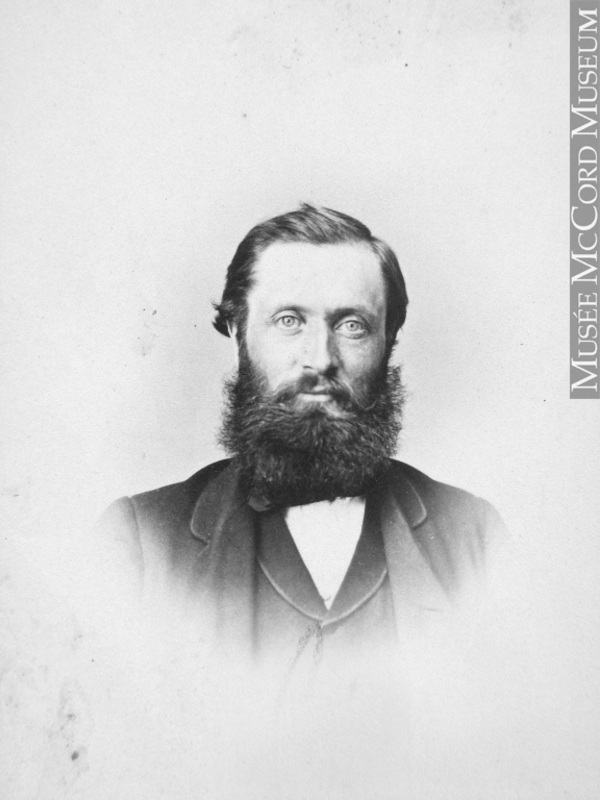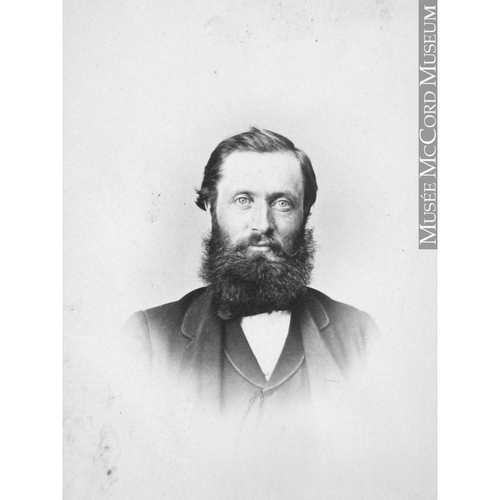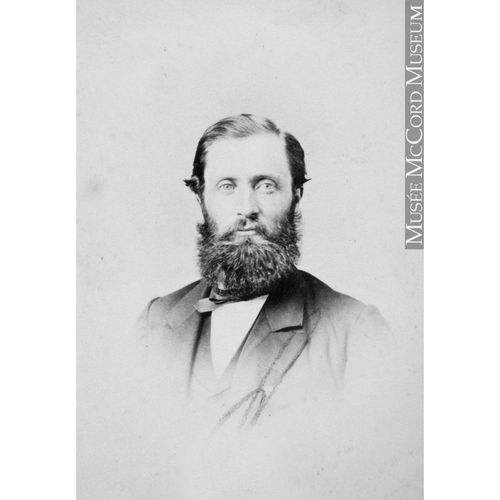
Source: Link
ROBERTSON, ANDREW, businessman and public servant; b. 18 June 1827 at Paisley, Scotland, son of Alexander Robertson and Grant Stuart Macdonald; m. 19 April 1850 Agnes Bow in Glasgow, Scotland, and they had ten children; d. 29 March 1890 in Montreal, Quebec.
Andrew Robertson received a classical education at the Paisley Grammar School, and then was instructed in the practical trade of weaving. In 1840 he moved to Glasgow and served the next four years in a dry goods store. At this time he took a position in a manufacturing establishment and was so successful that he was made a partner in 1848. Following medical advice, he immigrated in 1853 with his wife and two children to Montreal where he worked for the dry goods firm of Brown and Swan for two years. In 1855 or 1856 he established Andrew Robertson and Company, which specialized in yard goods. In the early 1860s Robertson built the Auburn Woolen Mill at Peterborough, Canada West, to manufacture Canadian tweed, only to sell the mill in 1867 in order to buy George Stephen*’s wholesale dry goods business in Montreal. Stephen’s youngest brother, Francis, joined Robertson in the firm of Robertson, Stephen and Company, and in 1874 Robert Linton also became a partner. Robertson retired from the business in 1885, and at his death five years later left an estate valued at between $350,000 and $400,000. In 1891 Linton acquired the interest held in the firm by Robertson’s heirs.
Robertson was known as a progressive, public-spirited, and charitable man. Early in his Montreal days he purchased and donated the land on which Erskine Presbyterian Church was built, and he was a member of that congregation until his death. He served twice as president of the St Andrew’s Society in the 1860s, and belonged to the St James Club. During the American Civil War he was active in the militia, and served as first lieutenant and quartermaster of the Montreal Light Infantry. He was appointed justice of the peace in 1884. In 1872 he became a governor of the Montreal General Hospital, and later served as its treasurer, vice-president, and president, finally bequeathing $5,000 to the institution. Robertson was also president of the Montreal Board of Trade in 1876 and 1877, and of the Dominion Board of Trade in 1876. He was the first president in 1874 of the Commercial Travellers’ Association of Canada, president of the Royal Canadian Insurance Company from 1876 to 1890, and president of the Bell Telephone Company of Canada from its establishment in 1880 until his death. He was also closely associated with Andrew Allan* and Alexander Walker Ogilvie* in forming the Citizens’ Gas Company which in the early 1880s attempted unsuccessfully to challenge the domination of the Montreal Gas Company. In 1881 he journeyed to British Columbia with Sir Charles Tupper*, who described Robertson as a “merchant prince,” in order to report on the feasibility of the Canadian Pacific Railway building a line between Victoria and Nanaimo. Although Robertson recommended such a move, the CPR did not undertake the construction.
Sir John A. Macdonald* was returned to power in 1878, and the next year he appointed Robertson, a Conservative supporter, to replace Thomas Cramp, a Liberal appointee, on the Montreal Harbour Commission. His fellow commissioners soon elected him chairman, a position he held until his death, when he was succeeded by Henry Bulmer. The commission, which came under federal jurisdiction, drew its revenues from charges on shipping. Throughout Robertson’s chairmanship the board was deeply in debt for improvements made previously in the harbour and for the deepening of the ship channel between Quebec and Montreal. In 1887, for example, the interest payment on its debt was over $220,000, and from 1881 to 1887 (with the exception of 1882), it experienced annual deficits of between $14,000 and $60,000. Further necessary improvements suffered accordingly. Simultaneously, Robertson had to contend with pressures to preserve Montreal’s competitive position with respect to American ports by further deepening the harbour and channel and by creating additional berths through the extension of wharves and the construction of new piers. Moreover, port users demanded reduced shipping dues, but since the necessary improvements could be financed only through the commission’s revenues, Robertson could introduce only modest reductions. Finally in 1888, despite widespread opposition, especially in Quebec City, the federal government assumed the commission’s debt for the channel and freed it to pursue improvements.
Of special concern to Robertson was the damage and suffering caused by the floods which inundated large parts of Montreal in 1885, 1886, and 1887. Floods had been a serious problem from the earliest days of the city, but by the mid 1880s it was generally agreed that they could be tolerated no longer. Robertson played an important part in the negotiations between the harbour commissioners, the federal government, the city of Montreal, the Grand Trunk and the Canadian Pacific railways, the Montreal Board of Trade, and some private parties, all of whose interests were involved in flood control. The final master plan called for the construction of a guard pier to protect the waterfront from ice, the raising of the wharves above high water level, and the general improvement of railway and harbour facilities. Agreement had been reached but work had not yet begun at the time of Robertson’s death in 1890.
Andrew Robertson was a less colourful and controversial figure than John Young*, a fellow immigrant from Scotland and a well-known predecessor on the harbour commission. As a successful businessman who participated fully in the commercial and social life of the city, Robertson’s achievements were substantial, but his most significant contribution was made in his capacity as chairman of the harbour commission. Undoubtedly his reputation for personal integrity and his wide contacts within the community were assets in the negotiations which resulted in the federal government assuming the channel debt, a necessary step enabling the harbour commission to undertake major works in flood control and to provide adequate facilities for the growing needs of the port of Montreal.
Andrew Robertson was the author of Montreal a free port . . . ([Montreal], 1880) and of Statement made by Mr. Andrew Robertson, chairman, harbour commissioners, Montreal, on the business of the port for the year 1886 . . . ([Montreal], 1887).
National Harbours Board (Montreal), Port of Montreal arch., Montreal Harbour Commission, Letterbooks, 1879–90; Minute books, 1879–90. Harbour Commissioners of Montreal, Annual reports (Montreal), 1879–90. Charles Tupper, Recollections of sixty years (Toronto, 1914). Borthwick, Hist. and biog. gazetteer. Terrill, Chronology of Montreal. Atherton, Montreal, II–III. Rumilly, Hist. de Montréal, III.
Cite This Article
D. Suzanne Cross, “ROBERTSON, ANDREW (1827-90),” in Dictionary of Canadian Biography, vol. 11, University of Toronto/Université Laval, 2003–, accessed January 21, 2025, https://www.biographi.ca/en/bio/robertson_andrew_1827_90_11E.html.
The citation above shows the format for footnotes and endnotes according to the Chicago manual of style (16th edition). Information to be used in other citation formats:
| Permalink: | https://www.biographi.ca/en/bio/robertson_andrew_1827_90_11E.html |
| Author of Article: | D. Suzanne Cross |
| Title of Article: | ROBERTSON, ANDREW (1827-90) |
| Publication Name: | Dictionary of Canadian Biography, vol. 11 |
| Publisher: | University of Toronto/Université Laval |
| Year of revision: | 1982 |
| Access Date: | January 21, 2025 |





